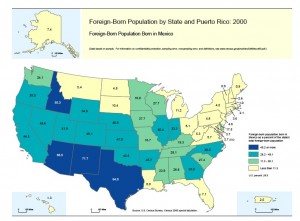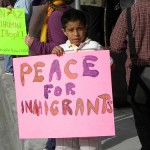Future of US Immigrants Uncertain in the Face of Policy Overhaul
Look for yet another cutback in the coming year. But this cutback won’t be on jobs, pay or life’s many luxuries. This cutback will be in the number of immigrants welcomed into the United States. Immigration reform is about to take center stage, and lowering quotas on the number of immigrants allowed into the United States is a very real possibility.
In the 2000 census, more than 31 million foreign-born people were living in the United States legally. There is no way to know the exact number of illegal immigrants in the U.S., but some estimate it to be as high as 22 million.
The debate over immigration reform sits on the backburner while President Barack Obama first tackles health care. Once that is done though, it could be his next big initiative. This means change could be on the way for more than 10 percent of the country and five percent of Indianapolis.
Weighing the Options
President Obama supports immigration reform that would provide some sort of amnesty for illegal immigrants already in the United States. What is still unknown is the way amnesty will be determined.
One proposed plan would grant amnesty to parents whose children were born in the U.S. and are legal citizens. Terri Downs, director of the Indianapolis Immigrant Welcome Center, supports this initiative, as well as a system that awards points to illegal immigrants applying for amnesty. Those who have been in the U.S. working, paying taxes and staying out of legal trouble would be given preference. Obama’s website says that he and Vice President Joe Biden “support a system that requires undocumented immigrants who are in good standing to pay a fine, learn English, and go to the back of the line for the opportunity to become citizens.”
“If your family is starving, and you know you can cross the line and reestablish your family, and find some stability and offer your children opportunities you were not afforded, then it’s even more likely you’d be able to find some success in the United States,” Downs said.
Not everyone is supportive of amnesty though. The Federation for American Immigration Reform calls for an end to amnesty. FAIR said amnesty programs only increase the incentive for illegal immigration. FAIR would also like to see legal immigration quotas enforced, cutting yearly immigration from one million immigrants each year to 300,000. This would match the out-migration numbers and help control rising populations.

A map compiled by the U.S. Census Bureau shows the rising Hispanic population in Indianapolis

A map compiled by the U.S. Census Bureau shows the rising Hispanic population in Indianapolis
The Process
While immigration populations in Indianapolis have stayed far below the national average, only about five percent, the number of foreign-born people living in Indianapolis has more than doubled since 1990. Because of such a recent influx, only one in three Indianapolis immigrants is a U.S. citizen.Nydia Auchter, a native Nicaraguan, is one of them. Auchter came to the United States in 2001 and became a naturalized citizen this year because it made it easier for her to travel back to Nicaragua and see her family. But it wasn’t an easy process.
“It’s a very difficult process and it’s very denigrating,” Auchter said. “When you go to the embassy you’re treated like you’re something different.”
Auchter, whose daughter has just been approved for a visa to come to the U.S., has been lucky though. She hasn’t faced many of the problems that plague other Hispanic immigrants in the city. Her American husband is a professor at Butler University. Their family has no trouble supporting itself, unlike many immigrant families.
“We know many immigrants and refugees work two or three part-time jobs just to be able to keep food on their table,” Downs said.
Making a Difference
Downs runs the center by herself, but served over 2,500 immigrants and refugees last year with the help of immigrants she calls “natural helpers.” Natural helpers have been through the system already. They take immigrants new to the city and help introduce them to the resources they’ll need to be successful in Indianapolis. After utilizing the Immigrant Welcome Center, Auchter now serves as a natural helper.
“Knowing that experience myself I thought that I would be able to help these people better,” she said.
Downs does not ask immigrants that come to her about their legal status. Her goal is to help connect them to the city and support immigrants with basic needs regardless, but said she has worked with both legal and illegal immigrants.
“The common perception is that all immigrants are illegal,” Downs said. “That’s not true.”
While Downs said she is excited to see Obama tackle immigration reform, she knows that, with strong feelings on both sides of the issue, it will be a heated debate.
“There is going to be a huge amount of public debate on it,” Downs said, “but America is a country of immigrants. We are all immigrants.”
Can you pass the Unites States citizenship test? Here is a sampling of five questions.
What is the supreme law of the land?
a. The Constitution
b. Civil Law
c. Common Law
2. How many amendments does the constitution have?
a. 10
b. 22
c. 27
3. We elect a U.S. Senator for how many years?
a. 4
b. 6
c. 2
4. If both the President and the Vice President can no longer serve, who becomes President?
a. Speaker of the House
b. Secretary of Defense
c. Secretary of State
5. Who was the President during World War I?
a. Franklin D. Roosevelt
b. Woodrow Wilson
c. William Howard Taft
(Answers at the bottom of the page)
Do you think the U.S. should award amnesty to illegal immigrants?
For More Information:
Immigrant Welcome Center
U.S. Citizenship and Immigration Services
The Federation for American Immigration Reform
Organizing For America|BarakObama.com
q ‘ɐ ‘q ‘ɔ ‘ɐ :sɹǝʍsuɐ
Filed Under: News

